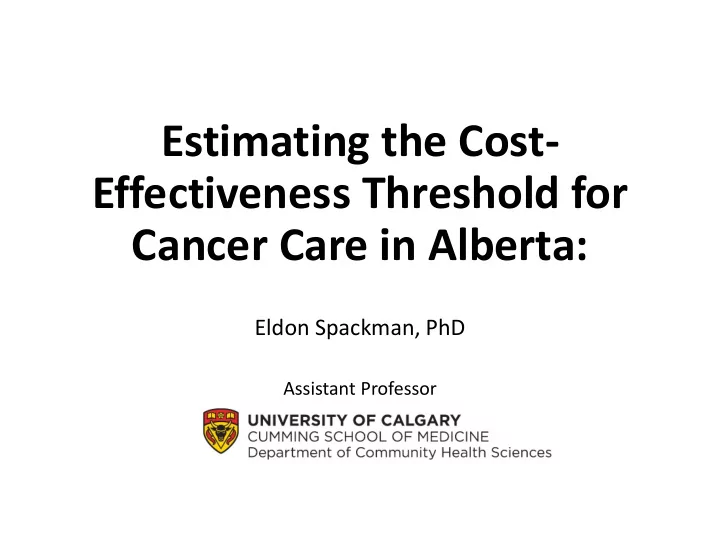

Estimating the Cost- Effectiveness Threshold for Cancer Care in Alberta: Eldon Spackman, PhD Assistant Professor
Contributors • Mike Paulden, PhD: University of Alberta • Chris McCabe, PhD: University of Alberta • Petros Pechlivanoglou, PhD: The Hospital for Sick Kids • Stafford Dean, PhD: Alberta Health Services • Anthony Fields, MD: Health Quality Council of Alberta • Vishva Danthurebandara, PhD: NS Ministry of Health • Funded by CIHR Project Grant: Health Services and Health Economics Research for Cancer Control
What is the threshold? • The ‘ threshold ’ is used in economic evaluations to determine if a health technology is ‘cost - effective’ • Two ways to use the threshold: 1. Compare the technology to the threshold • Cost-effective if ICER lies below the threshold: ∆𝐷 ∆𝐹 < 𝜇 • Cost-effective if net health benefit (NHB) is positive : ∆𝐹 − ∆𝐷 𝜇 > 0 • Cost-effective if net monetary benefit (NMB) is positive : ∆𝐹. 𝜇 − ∆𝐷 < 0 2. Use threshold to estimate value based price
Why a Threshold? • Threshold critical to assess cost-effectiveness • Constraints on growth in health expenditure • Advantages of explicit basis for threshold • Transparent and accountable • Appropriate signals of value for investments to meet future health needs
How a Threshold? 1. Infer a threshold from past decisions 2. Estimate value of what gets displaced 3. Estimate the relationship between changes in expenditure and outcomes • Martin et al. and Claxton et al.
Data for all individuals with a cancer ICD since 2005 • Available data during the follow-up period (8 years from 2005 – 2013) for 283,239 individuals. • Dataset contains variables for event status (dead or censored), time-to-event, demographics, costs and 1982 ICD variables. • Costs include, emergency department, inpatient, specialist, general practice and urgent care center costs.
The Model • Dependent variable • Accelerated failure time (AFT) models • Time to Death • Three distributional • Explanatory variable assumptions • Average annual cost since • Weibull diagnosis • Log-Logistic • Control variables • Logistic • Age • Models trained for • Sex randomly selected patients • Total number of ICDs and validated for another • Number of distinct ICDs randomly selected set • Low survival • Material deprivation quintile • Model Diagnostics • Social deprivation quintile • BIC, RMSE and ROC • 1982 ICDs
Predicting HRQoL • Use an algorithm that predicts UK EQ-5D from ICD9 • Sullivan et al. 2011 • Convert ICD9 to ICD10 • For unavailable variables • Assume national averages: race, income, education level • Disregard: non-cancer diagnoses • Predict HRQoL per patient • Average HRQoL = 0.654 • Claxton et al = 0.66 + 3% improvement
Population Characteristics One cancer ICD Two cancer ICDs in Year Training Set Validation Set Training Set Validation Set Sample Size 150,000 133,239 44,797 22,399 Proportion Male 50.5% 50.3% 48.5% 48.0% Average Age 57.7 57.7 59.1 59.0 Average Year of Diagnosis 2007.8 2007.8 2009.5 2009.5 Average total costs $36,094 $35,807 $47,115 $46,972 Average annual costs $12,395 $12,238 $17,852 $17,945 Died 35.0% 35.0% 54.8% 54.9%
Model Selection .15 .2 .15 .1 .1 .05 .05 0 0 0 20 40 60 80 0 50 100 150 200 Weibull LogLogistic .25 Weibull Log-logistic Logistic .2 BIC 84568 84483 84857 .15 AUC 0.8602 0.8682 0.8677 .1 RMSE 1.8583 1.5491 1.4316 .05 0 0 10 20 30 40 Logistic
Regression Results 1 ICD 2 ICDs Parameter Value SE Value SE Intercept 13.3847 0.1330 13.0053 0.0998 Sex -0.1469 0.0248 -0.1105 0.0239 Age -0.0440 0.0009 -0.0339 0.0009 Total ICD -0.0848 0.0012 -0.0654 0.0011 Distinct ICD 0.0312 0.0023 0.0284 0.0022 Low Survival 1.0122 0.0302 1.0095 0.0295 Avg. Cost 0.1198 0.0118 0.0299 0.0180 MDQ -0.0004 0.0071 0.0150 0.0070 SDQ 0.0040 0.0074 -0.0092 0.0073
Draft ICER Results 1 Cancer ICD ICER Model LE Avg Cost Elasticity ICER /LYG Utility + 3% /QALY Logistic 12.1 $12,395 0.00119 $8,611 0.654 0.674 $12,775 2 Cancer ICDs in a Year ICER Model LE Avg Cost Elasticity ICER /LYG Utility + 3% /QALY 12.5 $ 17,852 0.000297 $48,231 0.674 $71,552 Logistic 0.654
Conclusions • Routinely collected administrative data allows us to estimate marginal productivity by ICD chapter • Including ICDs seems to control sufficiently to avoid endogeneity • Marginal productivity differs by population
Recommend
More recommend